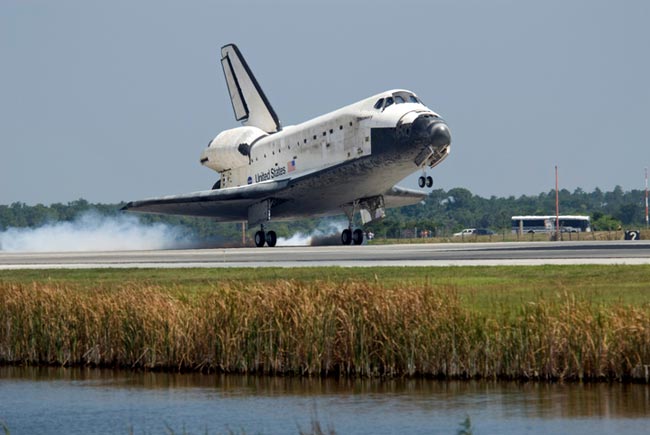Shuttle's Landing Success Sets Stage for Hubble Mission

CAPECANAVERAL, Fla. — With the successful Saturday return of the space shuttleDiscovery, the stage is set for NASA?s next flight: the final visit to theHubble Space Telescope.
Discovery?sseven-astronaut crew landed at 11:15 a.m. EDT (1515 GMT) here at NASA?s KennedySpace Center after a successful two-week mission that delivered Japan?s billion-dollarKibo laboratory to the International Space Station (ISS).
?It?s greatto be here on the runway in sunny Florida,? Discovery commander Mark Kelly saidafter the smoothlanding. ?The vehicle?s in good shape, which we always like to see it thatway.?
Discovery?sreturn to Earth clears the way for the planned Oct. 8 launch of its sister shipAtlantis, which is set to fly one last mission to overhaulthe Hubble Space Telescope before NASA turns its full attention to completingthe space station by 2010 and retiring its three-orbiter fleet.
But first,NASA has to fix blast damage to its prime shuttle launch site — Pad 39A — afterDiscovery?s liftoff ripped some 5,300 heat-resistant bricks from their concretemoorings at the 1960s-era pad.
NASA hastwo seaside shuttle launch sites, Pad 39A and Pad 39B, but is converting thelatter to host future flights of its new Ares I rocket and Orion crew capsules.However, both pads are required for the Hubble mission since, unlike station-boundflights, Atlantis astronauts won?t have the safe haven of the ISS to turn to iftheir spacecraft is damaged because the space telescope is in a differentorbit. Instead, a second shuttle would be readied at Pad 39B to serve as arescue ship, NASA has said.
MichaelLeinbach, NASA?s shuttle launch director, said there is ample time to complete repairsto Pad 39A before late August, when the agency plans to roll Atlantis outto the Pad 39A.
Get the Space.com Newsletter
Breaking space news, the latest updates on rocket launches, skywatching events and more!
?A lot of folksfeel like we have pretty sufficient amount of time available to do a repair andmake it flyable again, well in time for the Hubble mission,? Leinbach said. ?It?sa significant job, but the team is up to it.?
With nearlyfour months until the next launch, a planned gap due to fuel tank delays, thereshould also be enough time to give shuttle engineers some well-deserved timeoff, he added.
Orbitalscience ahead
In themeantime, NASA plans to make the most of the months between now and the nextshuttle flight to the space station, a logistics flight currently slated to liftoff on Nov. 10 aboard the Endeavour orbiter.
WilliamGerstenmaier, NASA?s associate administrator of space operations, said heexpects U.S. astronaut Gregory Chamitoff and his two Russian crewmates aboardthe station to take advantage of the shuttle lull to perform science in thestation?s new Kibo laboratory and Europe?s Columbus lab, which was delivered earlierthis year. Chamitoff arrived at the station last week aboard Discovery andreplaced U.S. astronaut Garrett Reisman as an Expedition 17 flight engineer.
Built bythe Japan Aerospace Exploration Agency (JAXA), Japan?s 37-foot (11-meter) Kibolab is about the size of a large tour bus and the largest room ever launched tothe space station. JAXA officials hope to begin the first experiments in the modulein August to christen a Japanese space laboratory that has been more than 20years in the making.
?I waspersonally moved that Kibo is now in space,? said JAXA vice president KaoruMamiya, who remembers helping to plan the new laboratory on paper two decadesago. ?It was my dream to see Kibo in space and that dream has come true.?
- New Video: Shuttle Discovery's Space Station Victory Lap
- New Video: Shuttle Booster's Wild Ride
- Video: Grand Opening for Station's Kibo Lab
Join our Space Forums to keep talking space on the latest missions, night sky and more! And if you have a news tip, correction or comment, let us know at: community@space.com.

Tariq is the Editor-in-Chief of Space.com and joined the team in 2001, first as an intern and staff writer, and later as an editor. He covers human spaceflight, exploration and space science, as well as skywatching and entertainment. He became Space.com's Managing Editor in 2009 and Editor-in-Chief in 2019. Before joining Space.com, Tariq was a staff reporter for The Los Angeles Times covering education and city beats in La Habra, Fullerton and Huntington Beach. In October 2022, Tariq received the Harry Kolcum Award for excellence in space reporting from the National Space Club Florida Committee. He is also an Eagle Scout (yes, he has the Space Exploration merit badge) and went to Space Camp four times as a kid and a fifth time as an adult. He has journalism degrees from the University of Southern California and New York University. You can find Tariq at Space.com and as the co-host to the This Week In Space podcast with space historian Rod Pyle on the TWiT network. To see his latest project, you can follow Tariq on Twitter @tariqjmalik.









